
The red-billed blue magpie is a species of bird in the crow family, Corvidae. It is about the same size as the Eurasian magpie, but has a much longer tail, one of the longest of any corvid. It is 65–68 cm (25.5–27 in) long and weighs 196–232 g (6.9–8.2 oz).

The common green magpie is a member of the crow family, roughly about the size of the Eurasian jay or slightly smaller. In the wild specimens are usually a bright and lush green in colour, slightly lighter on the underside and has a thick black stripe from the bill to the nape. Compared to the other members of its genus, the white-tipped tail is quite long. This all contrasts vividly with the red fleshy eye rims, bill and legs. The wings are reddish maroon.

The black-headed lapwing or black-headed plover is a large lapwing, a group of largish waders in the family Charadriidae. It is a resident breeder across sub-Saharan Africa from Senegal to Ethiopia, although it has seasonal movements. It lays two or three eggs on a ground scrape.
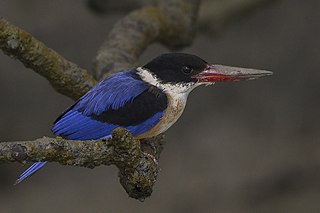
The black-capped kingfisher is a tree kingfisher which is widely distributed in tropical Asia from India east to China, Korea and Southeast Asia. This most northerly of the tree kingfishers is resident over much of its range, but northern populations are migratory, wintering south of their range in Sri Lanka, Thailand, Borneo and Java. It is distinctive in having a black cap that contrasts with the whitish throat, purple-blue wings and the coral red bill. The species is mainly found in coastal and mangrove habitats but can sometimes be found far inland.

The western plantain-eater, also known as the grey plantain-eater or western grey plantain-eater, is a large member of the turaco family, a group of large arboreal near-passerine birds restricted to Africa.

The white-naped woodpecker is woodpecker which is a widespread but a scarce breeder in the Indian Subcontinent. It is associated with open forest and scrub with some trees. It nests in a tree hole, laying one or two white eggs.
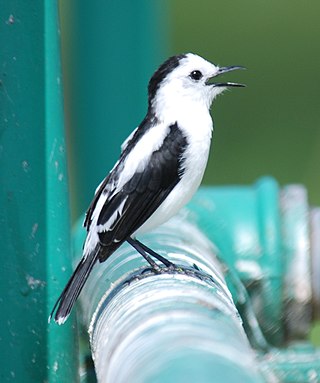
The pied water tyrant is a small passerine bird in the tyrant flycatcher family. It breeds in tropical South America from Panama and Trinidad south to Bolivia.

The long-tailed parakeet or Burung Bayan Nuri in Malay is a parakeet endemic to the regions of Andaman and Nicobar islands, Sumatra, Borneo and Peninsular Malaysia. It is allopatric with the congener, the Red-breasted parakeet, Psittacula alexandri, except in the Andaman islands where they occur together.

The great-billed parrot also known as Moluccan parrot or island parrot, is a medium-sized, approximately 38 cm long, green parrot with a massive red bill, cream iris, blackish shoulders, olive green back, pale blue rump and yellowish green underparts. The female is typically smaller than the male, but otherwise the sexes are similar.

The Greater Antillean grackle is a grackle found throughout the Greater Antilles, as well as smaller nearby islands. Like all Quiscalus grackles, it is a rather large, gregarious bird. It lives largely in heavily settled areas.

The Madagascar ibis, also known as the Madagascar crested ibis, white-winged ibis or crested wood ibis, is a medium-sized, brown-plumaged ibis. It has bare red orbital skin, yellow bill, red legs, white wings and its head is partially bare with a dense crest of green or gloss blue and white plumes on the nape. The Madagascar ibis is the only member of the genus Lophotibis.
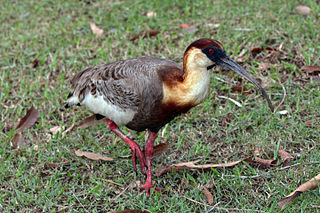
The buff-necked ibis, also known as the white-throated ibis, is a fairly large ibis found widely in open habitats of eastern and northern South America. It formerly included the similar black-faced ibis as a subspecies, but that species is almost entirely restricted to colder parts of South America, has a buff lower chest, and lacks the contrasting large white wing-patches.
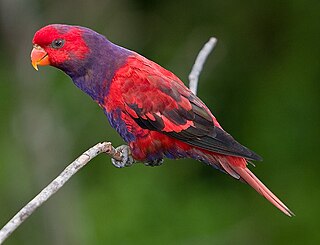
The violet-necked lory is a species of parrot in the family Psittaculidae. It is endemic to Indonesia, where it is found in the northern Maluku Islands and west Papuan islands. Its natural habitats are tropical moist lowland forests and tropical mangrove forests.
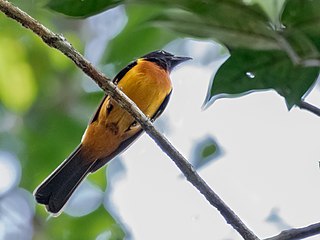
The fulvous shrike-tanager is a South American bird in the tanager family Thraupidae. It is found in Brazil, Colombia, Ecuador, French Guiana, Guyana, Peru, Suriname, and Venezuela. Its natural habitat is subtropical or tropical moist lowland forests.

The helmeted pygmy tyrant is a species of bird in the family Tyrannidae. It is found in Brazil, Colombia, French Guiana, Guyana, Peru, Suriname, and Venezuela. Its natural habitats are subtropical or tropical moist lowland forests and heavily degraded former forest.

The hooded tanager is a species of bird in the tanager family Thraupidae. It is found in Argentina, Bolivia, Brazil, Colombia, French Guiana, Guyana, Paraguay, Peru, and Venezuela. Its natural habitats are subtropical or tropical moist lowland forest, subtropical or tropical mangrove forest, and heavily degraded former forest.
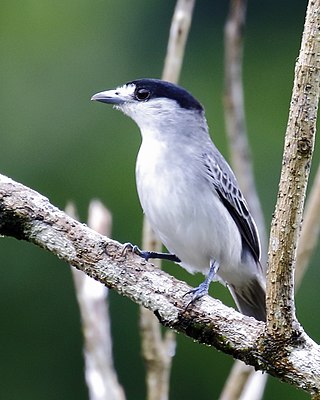
The cinereous becard is a species of bird in the family Tityridae. The term cinereous describes its colouration. It has traditionally been placed in Cotingidae or Tyrannidae, but evidence strongly suggest it is better placed in Tityridae, where it is now placed by the South American Classification Committee.

The rusty-collared seedeater is a species of bird in the family Thraupidae, formerly placed in the related Emberizidae.

The Nubian woodpecker is a species of bird in the family Picidae. It is distributed widely in Central and Eastern Africa, from Chad in west to Somalia in east and Tanzania in south. It is a fairly common species with a wide range, the population seems stable, and the International Union for Conservation of Nature has rated its conservation status as being of "least concern".
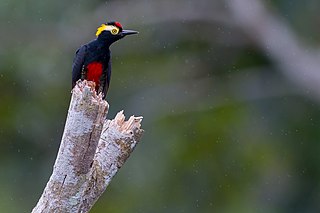
The yellow-tufted woodpecker is a species of woodpecker. It is found in Bolivia, Brazil, Colombia, Ecuador, French Guiana, Guyana, Peru, Suriname, and Venezuela. Its natural habitats are subtropical or tropical moist lowland forests and heavily degraded former forest.

























